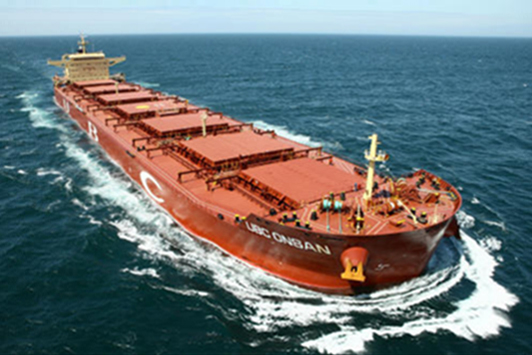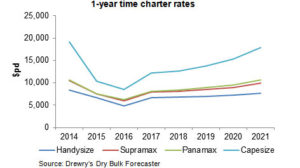
The global bulker market may see a reducti[ds_preview]on of overcapacity and a recovery, according to shipping consultancy Drewry.
Moderating vessel supply growth over the next few years together with a mild improvement in the outlook for seaborne trade are named as positive prospects for the market which is marked by a chronic overcapacity.
Drewry forecasts that Capesize bulker one-year time charter rates will double over the next five years from the lows of 2016. »The reasons for a sharp contraction in the supply and demand gap are improving demand outlook coupled with a slowdown in vessel supply due to high scrapping and continued low deliveries along with scarce new-orders«, it says in a new report released today.
One aspect is a surplus in scrapping activity, because the impending additional cost of installing Ballast Water Treatment Systems (BWTS) would force owners to keep sending younger tonnages to scrapyards. Another one is the reluctant order activity. »The continued scarcity of private equity has controlled new orders this year and investors are expected to keep shying away from the dry bulk market, thinning the orderbook even further over the next two years. This will ensure that bulker deliveries remain low which in turn will limit supply growth«, Drewry adds.

By contrast, demand for dry bulk shipping would grow strongly, as Brazil’s increasing share of Chinese iron ore imports drives higher tonne mile demand. »Even if the Chinese iron ore trade does not rise as anticipated, a shift of sourcing towards Brazil will mean that the demand for ships will increase many fold.« In addition, Asian countries, including Vietnam, Korea and Taiwan are expected to ramp up coal imports as they open more coal-powered generating plants to support their growing demand for energy. Drewry awaits coal demand to keep increasing over the next five years.
»Bulker shipping has bottomed out and a market recovery is underway, albeit a slow one. Rising demand for ships to cater for increasing raw material consumption, together with the effect of shifting trade routes will help increase tonne miles. With investment remaining out of reach from dry bulk owners, even a modest growth in demand will help support market recovery. Meanwhile, the increasing cost of running an old ship will mean more vessels go to scrapyards, tightening supply over the next five years,« commented Rahul Sharan, Drewry’s lead analyst for dry bulk shipping.



















